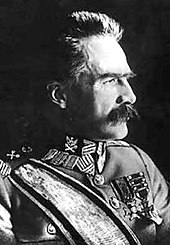Sanacja



Sanacja (from Latin sanatio for healing ) was the name given to the authoritarian regime in the Second Polish Republic under Józef Piłsudski and Edward Rydz-Śmigły between 1926 and 1939.
history
The term was coined by Pilsudski slogans during Maiputsches derived in 1926, where the " moral healing" (Pol. "Sanacja moralna") of the public life of society in Poland was called. Between 1928 and 1935, the Sanacja was embodied mainly by the non-partisan Bezpartyjny Blok Współpracy z Rządem (BBWR) bloc and the governments it established, mostly with ministers and prime ministers from the ranks of the Polish military . It propagated an authoritarian style of government and weakened the opposition by inciting its own supporters there to split the opposition parties into competing blocs. The center-left alliance Centrolew, led by Wincenty Witos , fought against this and was crushed in 1931 under the pretext of having planned a coup . In the Morges Front, founded by Ignacy Jan Paderewski in exile in Switzerland in 1936 , high-ranking military officials also organized themselves against the Sanacja, such as Władysław Sikorski and Józef Haller .
After Piłsudski's death in 1935, two centers of power emerged within the Sanacja - the “Castle” group (around Ignacy Mościcki , named after the residence of the President installed by Piłsudski, the Warsaw Royal Castle ) and the “Colonelists” group around the new Marshal Edward Rydz-Śmigły , mainly consisting of former members of the Blue Army and the Polish Legion .
characterization
The characterization of the Sanacja regime is controversial and can at best be described as an early form of the military regime . According to the historians Wolfgang Benz and Feliks Tych, the Sanacja with its nationalism, anti-communism and partly anti-Semitism showed fascist traits, even if it did not succeed in gaining such a broad mass base as Italian fascism or German National Socialism . British sociologist Michael Mann on the other hand expects the Sanacja to European government systems to the challenge of the Great Depression of the 1930s, not with fascism but with corporatism responded and authoritarianism. The British historian Norman Davies also denies that the regime can be called fascist, since the Polish sympathizers of fascism, who existed within the Narodowa Demokracja , were in opposition to it and formally it did not represent a dictatorship. In 1934, the Sanacja government also banned organizations and parties that were clearly fascist, such as the Falanga .
The Polish historian Jerzy Holzer sees tendencies towards the establishment of a fascist regime in Poland at the end of the 1930s, which were broken off by the German attack . However, they were by no means irreversible, since there was always strong resistance from the communist, socialist and democratic sides as well as from the Sanacja movement itself. Piłsudski himself accepted Poland as a multiethnic state, which is why Holzer instead suggests speaking of a strong but unfinished process of polarization within Polish society for the period before the Second World War . The historian Stephen Lee also considers the counterfactual question of whether Poland would have developed fully developed fascism under other circumstances as open, but emphasizes that the tendencies in this direction in Poland were not the result of a personality cult or the charism of a leader, but on the contrary Result of their absence: "Polish 'fascism' therefore served to conceal mediocrity rather than to project personal power."
Sanacja leaders
- Jozef Beck
- Kazimierz Bartel
- Janusz Jędrzejewicz
- Eugeniusz Kwiatkowski
- Ignacy Mościcki
- Józef Piłsudski
- Aleksander Prystor
- Edward Rydz-Śmigły
- Walery Sławek
- Kazimierz Świtalski
literature
- Włodzimierz Borodziej : History of Poland in the 20th Century , Munich 2010, ISBN 978-3-406-60648-9
- Norman Davies : In the heart of Europe. History of Poland , Munich 2006, ISBN 978-3-406-46709-7
- Jerzy Gaul: Pokój czy Wojna? Polityka Józefa Piłsudskiego wobec Związku Sowieckiego w świetle raportów dyplomatów austriackich 1926–1935 , in: Studia Humanistyczno-Społeczne 6/2012, pp. 31–51 ( pdf , shs.ujk.edu.pl)
- Christoph Kotowski: The “moral dictatorship” in Poland from 1926 to 1939. Fascism or an authoritarian military regime? , Munich 2012, ISBN 978-3-656-13544-9
Individual evidence
- ↑ Feliks Tych: Legitimation ideologies of the Pilsudski rule. In: Richard Saage (ed.): The failure of dictatorial legitimation patterns and the future viability of democracy. Festschrift for Walter Euchner. Duncker & Humblot, Berlin 1995, pp. 185-188; Wolfgang Benz : Fascism . In: the same (ed.): Handbuch des Antisemitismus , Volume 3: Terms, Theories, Ideologies. Walter de Gruyter, 2010, ISBN 978-3-11-023379-7 , p. 86 (accessed via De Gruyter Online).
- ↑ Michael Mann: Fascists. Cambridge University Press, Cambridge 2004, p. 363.
- ↑ Norman Davies: In the Heart of Europe. History of Poland. Fourth, revised edition. CH Beck, Munich 2006, p. 114.
- ^ Jerzy Holzer: The Political Right in Poland, 1918-39. In: Journal of Contemporary History 12, No. 3 (1977), pp. 395-412, here p. 410 f.
- ↑ Stephen J. Lee: European Dictatorships, 1918-1945 . Routledge, London / New York 2000, p. 270.